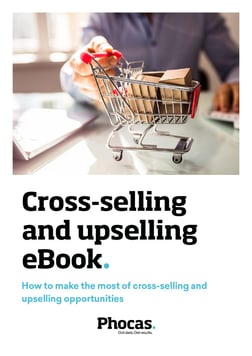Cross-selling know-how for front-line staff

Branches are the front lines of your business, leading the charge when it comes to customer touch points and building customer loyalty. Branch managers, their sales teams and support staff know your customers — many on a first name basis — and are the most qualified to recommend cross-selling opportunities to grow business. The best way to strengthen your front line is to give them access to the data that is relevant to their operations and customers, empowering them to cross-sell well.
Branches will benefit the most by having access to data analytics where they can track and monitor their branch performance, review sales reports and have a clear picture of current inventory levels and pricing strategies to help your customers and your bottom line.
Armed with data, your team can reduce the need to make decisions based on gut feel, using information to drive cross sales and customer engagement.
The benefits of cross-selling
The ability to cross sell starts with understanding your customers’ buying habits. By understanding what your customers are buying – and more importantly what they are not – you will be able to provide opportunities to your sales team so they can identify where there is potential profit. Cross-selling, when done well, is a technique that can have a positive impact on your bottom line.
Cross-selling is when your sales team invites the customer to buy related or complementary products that will add value to the initial sale, while upselling is converting an initial product order into a more premium version.
Cross-selling allows you to generate additional sales revenue by incentivizing existing customers to purchase more of what they need.
The benefits of cross-selling to your business and branch/retail networks are plentiful. They can include increasing the average transactional value, thus increasing average invoice value; introduce new products, increasing the range of products sold and increasing revenue per customer. Other benefits include:
- Low cost - You might assume that to increase sales revenue, you must increase your customer base, but that’s not the case. A cross-selling strategy focuses on increasing sales to existing customers, saving you the time and money involved with new customer acquisition. And we all know it’s a lot less expensive to keep current customers than to acquire new ones.
- Better customer retention – Customers stay with you when they are happy. When they see value in what you offer them it builds trust and loyalty. Getting the most value out of a transaction with an existing customer not only makes you more money at the time of transaction, it also saves you money by maximizing an existing customer relationship.
- Immediate sales – A cross-sell opportunity is identified during a transaction, and if successful, becomes part of that transaction. In other words, it’s an immediate increase in revenue during a single sales cycle.
Cross-selling success story
Tropic Supply (Tropic) has served the HVAC/R industry in Florida for the past 45 years, opening its doors in 1973 out of a warehouse in Miami. Since that time, the company has added 21 new branches, covering both coastlines from Miami to Jacksonville and Tallahassee to Naples.
One of the main benefits of data analytics is getting the right sales information into the hands of the people that need it on a daily basis. Michael Clay, Director of IT & Operations with Tropic, says sales reports are critical, and our salespeople now run their own commission reports directly from Phocas.
Tropic added branch managers to Phocas to enhance autonomy and to provide cross-selling opportunities. Tropic is using the sales data to run branch promotions, in one case incentivizing the counter team with a performance bonus based on the number of customers spending $10k or less that they could get to spend more with the company.
“We turned around a few customers and were able to flip some to better pricing levels,” said Clay. “Perhaps more importantly, we have team members specifically assigned to work with these customers, which lets them know that we care about their business and is having an impact on retention.”
Despite the clear benefits, not many businesses make cross-selling a routine practice. As a rule, a cross-sell offer should tie in with relevant products and services, offer real value, and is simple and direct.
To learn more about the steps to successful cross-selling and upselling, click here, or on the button below.

Empowering businesses with intuitive data analytics, driving informed decisions for growth and profitability. We make people feel good about data.

When to use an operating budget for more detailed planning
What is an operating budget? An operating budget is a resourceful tool that enables businesses to estimate income projections and expected expenses and plan for low-earning or high-spending months. This financial plan provides data that constantly records the costs of your business operations for a specific period (mainly up to the end of the year). It also serves as an outline detailing how much money a company spends and incurring expenses.
Read more
Improve planning with comprehensive sales forecasting
If the owner of your business wants to expand to a new State, would you have the sales forecasting figures to know whether the business can afford to do that or not? Or, if you had to produce a 3–year solvency projection for the CEO, is your sales forecasting process robust enough to support a reliable analysis?
Read more
Behler-Young connects Amazon Alexa and Phocas BI with great results
Can you have a conversation with your business intelligence solution while driving? Behler-Young sales people do. Robert Wright, a Senior Application Developer and Analyst at Behler-Young, integrated Amazon Alexa with Phocas, a business intelligence solution for manufacturers, distributors and retailers. With critical data only a question away, they always know what's going on even when they're on the road.
Read more
7 effective sales team KPIs and metrics
Sales managers need to be savvy and strategic to get ahead. Fortunately, there are many advanced data measurement and analytics options available to help you motivate your team and drive performance.
Read more
Find out how our platform gives you the visibility you need to get more done.
Get your demo today